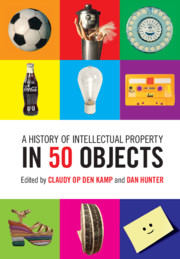Book contents
- Frontmatter
- Dedication
- Contents
- Acknowledgments
- Introduction: Of People, Places, and Parlance
- The Pre-Modern Period
- The Age of invention
- Modern Times
- The Consumption Age
- 26 Bell Transistor
- 27 Oral Contraceptive Pill
- 28 Photocopier
- 29 Elstar Apple
- 30 Chanel 2.55
- 31 Lego Brick
- 32 Barbie Doll
- 33 Coca-Cola Bottle
- 34 Zapruder Film
- 35 Audiotape Cassette
- 36 Action Figure
- 37 RAM-Chip
- 38 Football
- The Digital Now
- About The Contributors
28 - Photocopier
from The Consumption Age
Published online by Cambridge University Press: 12 June 2019
- Frontmatter
- Dedication
- Contents
- Acknowledgments
- Introduction: Of People, Places, and Parlance
- The Pre-Modern Period
- The Age of invention
- Modern Times
- The Consumption Age
- 26 Bell Transistor
- 27 Oral Contraceptive Pill
- 28 Photocopier
- 29 Elstar Apple
- 30 Chanel 2.55
- 31 Lego Brick
- 32 Barbie Doll
- 33 Coca-Cola Bottle
- 34 Zapruder Film
- 35 Audiotape Cassette
- 36 Action Figure
- 37 RAM-Chip
- 38 Football
- The Digital Now
- About The Contributors
Summary
THE STORY OF the invention of the photocopy machine—or the “Xerox machine” as many call it—dramatizes both cherished and contested features of intellectual property. It dramatizes the myth of the lone inventor, here Chester Carlson, born poor and disadvantaged, who made his fortune from the invention but not before toiling in a patent office and in his own start-up for decades. But the development of the Xerox machine is also the story of collaboration and teamwork, which is essential to most innovation with social impact. The origin of the Xerox machine demonstrates how need, a passion for puzzles, and the creative spirit motivate everyday inventors. And its success in the marketplace implicates the role ofbusiness leverage and profit in productive creativity and innovation. The story is about rivals and claims of stealingideas as well as about inevitable influence and borrowing, both which structure and inform incremental and ground-breaking invention. And if these tensions aren't enough, the intellectual property that protected the Xerox machine forbids copying and yet the Xerox machine is used to make copies. While the Xerox machine is a tool for making exact copies, it often facilitates transformative creativity from innumerable writers, artists, and musicians. The story of the Xerox machine is a microcosm of debates surrounding the proper purpose and scope of intellectual property and an object lesson in how irreconcilable dualities inform the everyday practice of intellectual property.
Chester (“Chet”) Floyd Carlson was born in Seattle, Washington in February 1906 into a family struggling with illness and poverty. Until he left for college, Chet looked after his parents both physically and financially. In high school, he feil in love with science. An early gift of a typewriter from his aunt and, later, the handcramping he experienced from verbatim copying of science and law books while taking night classes to advance his career prospects, made him dream of a device that could swiftly produce and copy text. In college, Chet studied physics and chemistry, as well as law, eventually moving to New York to work in the patent department of P.R. Mallory & Co., a manufacturer of electrical components. It was while working by day in that patent department and by night in his home laboratory in Astoria, Queens, when he invented the copying machine. As he describes it: “with the problem so sharply defined, the solution came almost as an intuitive flash.”
- Type
- Chapter
- Information
- A History of Intellectual Property in 50 Objects , pp. 232 - 239Publisher: Cambridge University PressPrint publication year: 2019

